Exploring the antiproliferative effect of PI3K/Akt/mTOR pathway and CDK4/6 inhibitors in human papillomavirus‑positive and ‑negative head and neck squamous cell carcinoma cell lines
- Authors:
- Femke Verhees
- Imke Demers
- Dion Legemaate
- Robin Jacobs
- Ann Hoeben
- Bernd Kremer
- Ernst-Jan Speel
-
Affiliations: Department of Otorhinolaryngology, Head and Neck Surgery, GROW Research Institute for Oncology and Reproduction, Maastricht University Medical Center, 6229HX Maastricht, The Netherlands, Department of Pathology, GROW Research Institute for Oncology and Reproduction, Maastricht University Medical Center, 6229HX Maastricht, The Netherlands, Department of Medical Oncology, GROW Research Institute for Oncology and Reproduction, Maastricht University Medical Center, 6229HX Maastricht, The Netherlands - Published online on: January 8, 2025 https://doi.org/10.3892/ijo.2025.5719
- Article Number: 13
-
Copyright: © Verhees et al. This is an open access article distributed under the terms of Creative Commons Attribution License.
This article is mentioned in:
Abstract
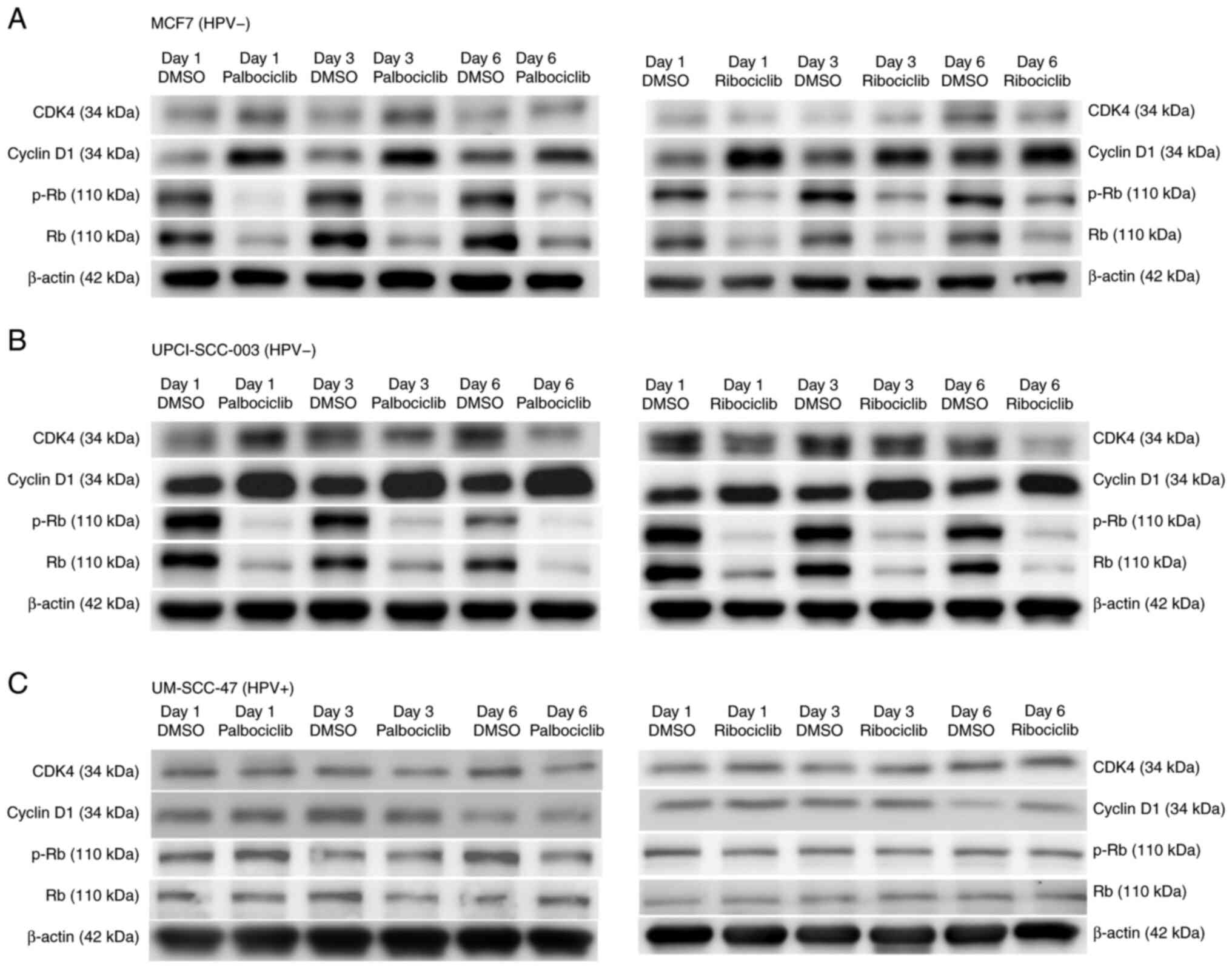 |
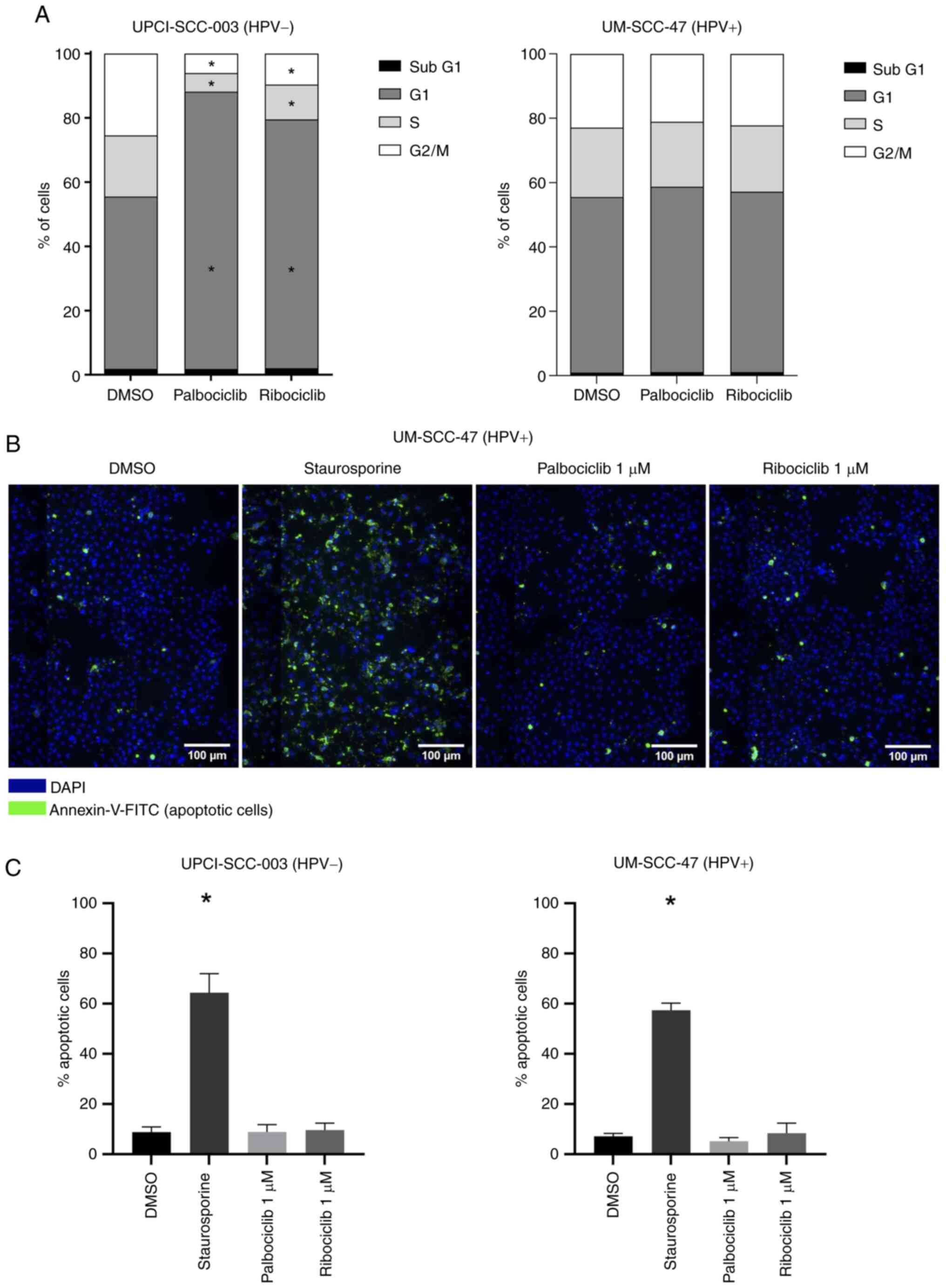 |
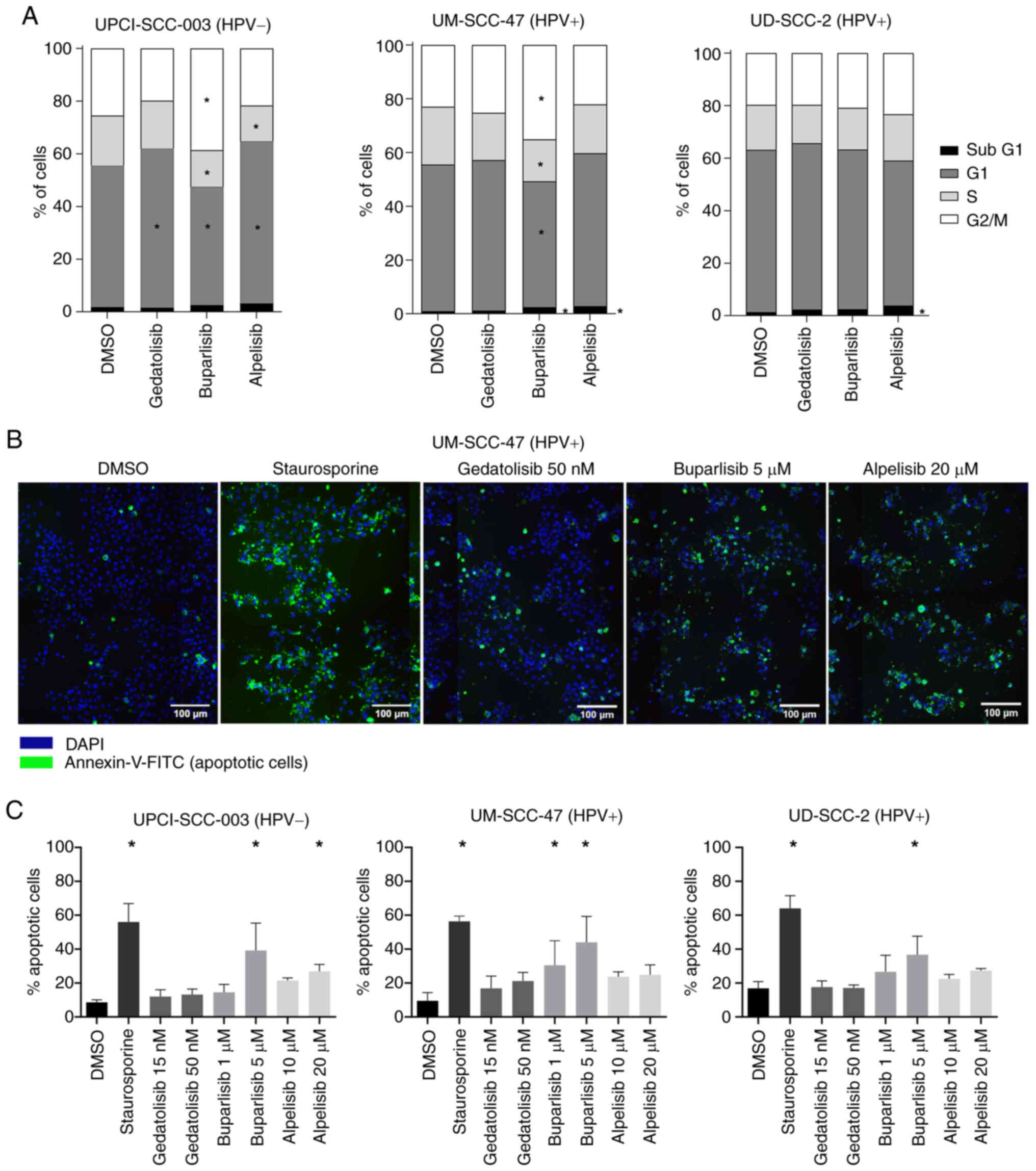 |
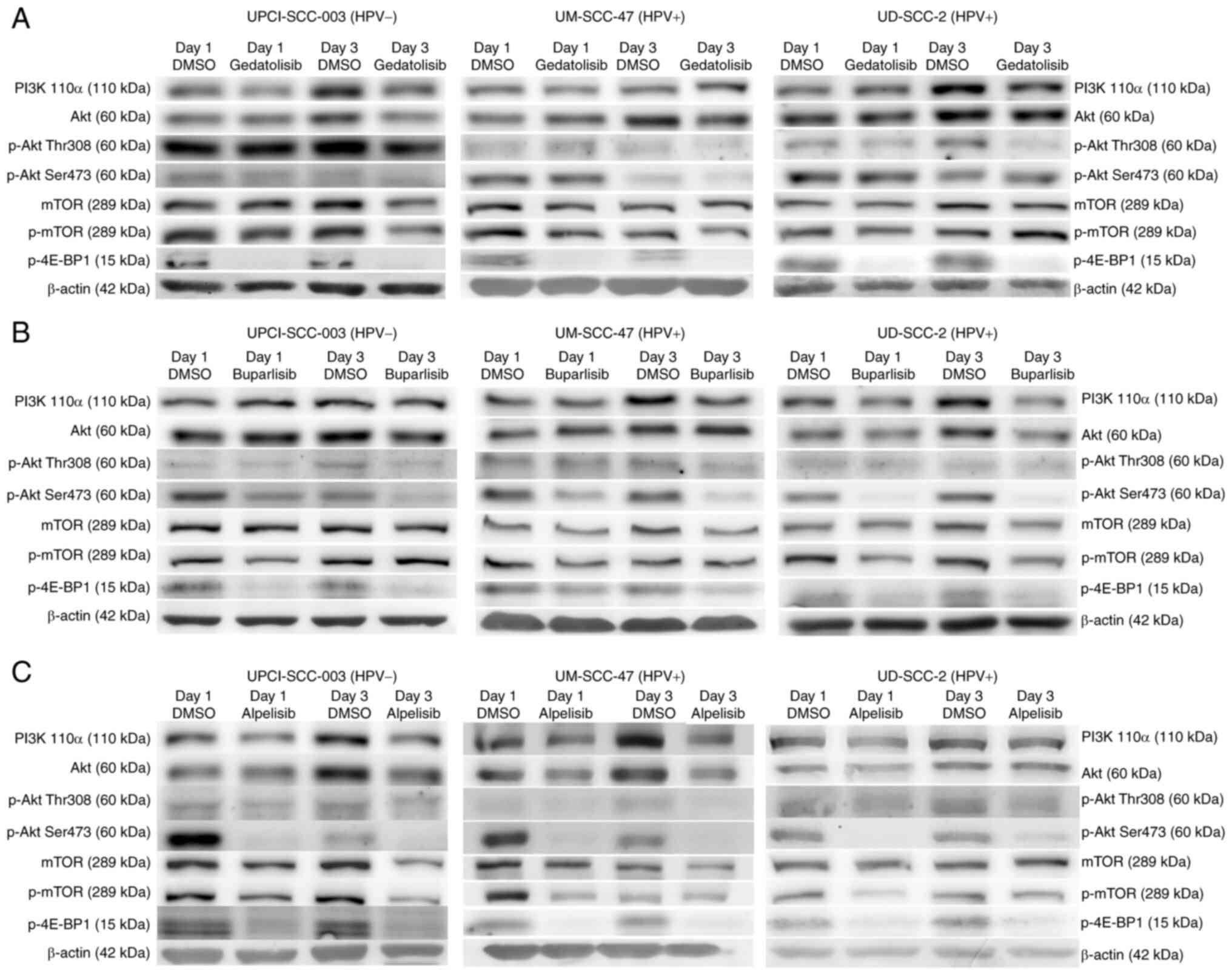 |
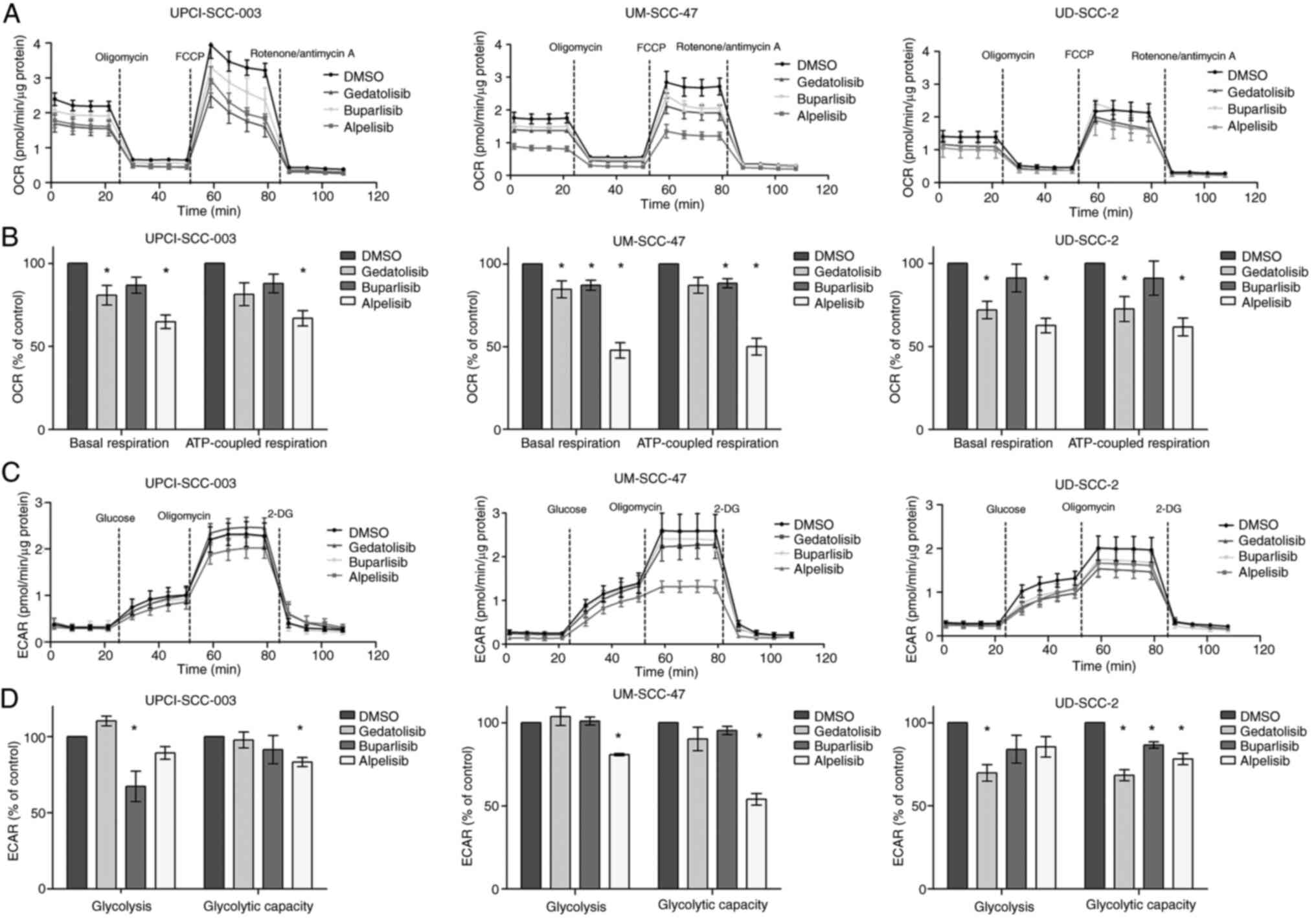 |
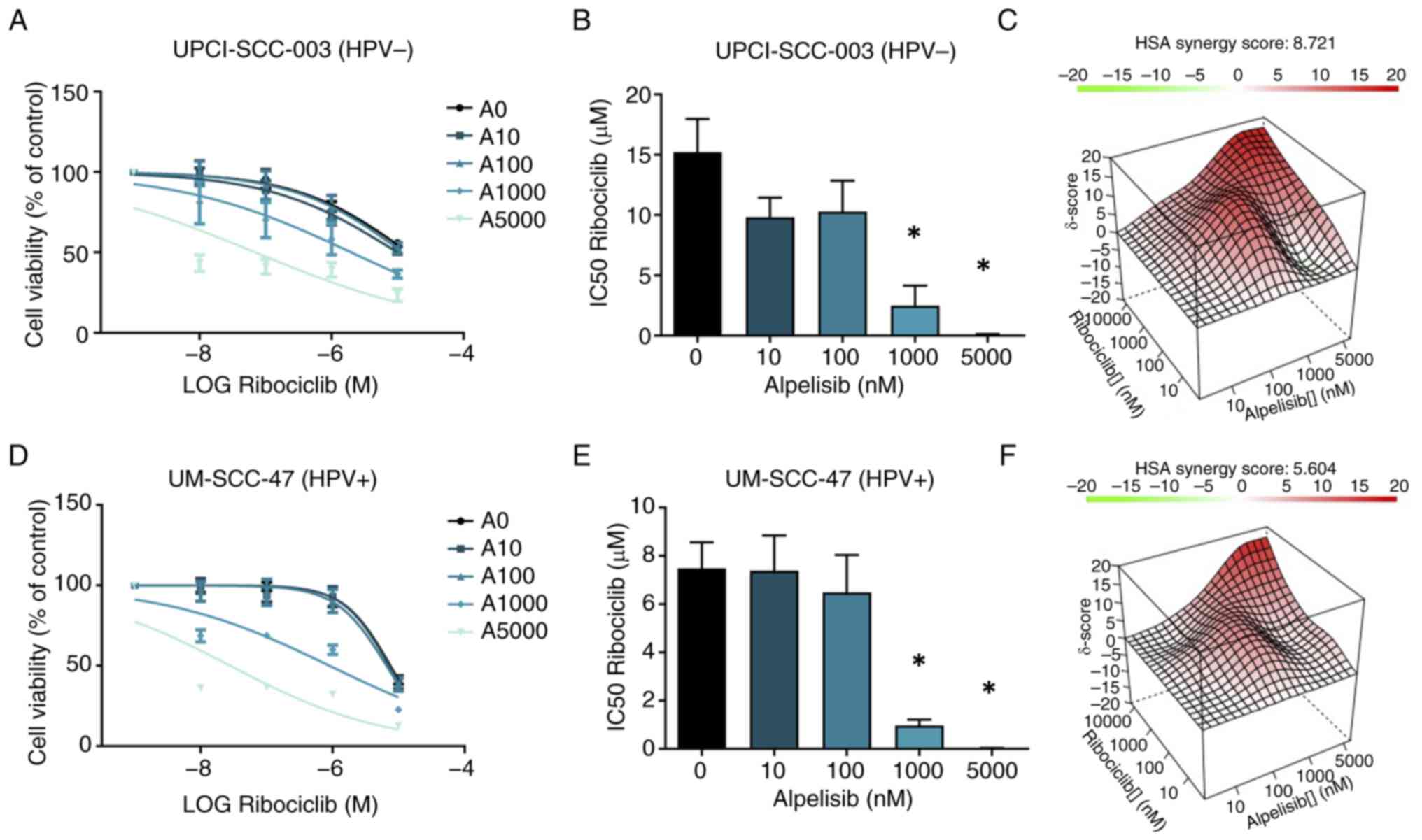 |
|
Siegel R, Naishadham D and Jemal A: Cancer statistics, 2013. CA Cancer J Clin. 63:11–30. 2013. View Article : Google Scholar : PubMed/NCBI | |
|
Bann DV, Deschler DG and Goyal N: Novel immunotherapeutic approaches for head and neck squamous cell carcinoma. Cancers (Basel). 8:872016. View Article : Google Scholar : PubMed/NCBI | |
|
Jemal A, Siegel R, Ward E, Hao Y, Xu J, Murray T and Thun MJ: Cancer statistics, 2008. CA Cancer J Clin. 58:71–96. 2008. View Article : Google Scholar : PubMed/NCBI | |
|
Gillison ML, Chaturvedi AK, Anderson WF and Fakhry C: Epidemiology of human papillomavirus-positive head and neck squamous cell carcinoma. J Clin Oncol. 33:3235–3242. 2015. View Article : Google Scholar : PubMed/NCBI | |
|
Stransky N, Egloff AM, Tward AD, Kostic AD, Cibulskis K, Sivachenko A, Kryukov GV, Lawrence MS, Sougnez C, McKenna A, et al: The mutational landscape of head and neck squamous cell carcinoma. Science. 333:1157–1160. 2011. View Article : Google Scholar : PubMed/NCBI | |
|
Hafkamp HC, Manni JJ, Haesevoets A, Voogd AC, Schepers M, Bot FJ, Hopman AHN, Ramaekers FC and Speel EJM: Marked differences in survival rate between smokers and nonsmokers with HPV 16-associated tonsillar carcinomas. Int J Cancer. 122:2656–2664. 2008. View Article : Google Scholar : PubMed/NCBI | |
|
Rosenquist K, Wennerberg J, Annertz K, Schildt EB, Hansson BG, Bladström A and Andersson G: Recurrence in patients with oral and oropharyngeal squamous cell carcinoma: Human papillomavirus and other risk factors. Acta Otolaryngol. 127:980–987. 2007. View Article : Google Scholar : PubMed/NCBI | |
|
Furness S, Glenny AM, Worthington HV, Pavitt S, Oliver R, Clarkson JE, Macluskey M, Chan KK and Conway DI: Interventions for the treatment of oral cavity and oropharyngeal cancer: Chemotherapy. Cochrane Database Syst Rev. Cd0063862011.PubMed/NCBI | |
|
Machiels JP, René Leemans C, Golusinski W, Grau C, Licitra L and Gregoire V; EHNS Executive Board; ESTRO Executive Board: Electronic address: simplesecretariat@ehns.org; ESMO Guidelines Committee. Electronic address: simpleclinicalguidelines@esmo.org. Electronic address: simpleinfo@estro.org. Squamous cell carcinoma of the oral cavitylarynx, oropharynx and hypopharynx: EHNS-ESMO-ESTRO clinical practice guidelines for diagnosis, treatment and follow-up. Ann Oncol. 31:1462–1475. 2020. View Article : Google Scholar : PubMed/NCBI | |
|
Agrawal N, Frederick MJ, Pickering CR, Bettegowda C, Chang K, Li RJ, Fakhry C, Xie TX, Zhang J, Wang J, et al: Exome sequencing of head and neck squamous cell carcinoma reveals inactivating mutations in NOTCH1. Science. 333:1154–1157. 2011. View Article : Google Scholar : PubMed/NCBI | |
|
Engelman JA: Targeting PI3K signalling in cancer: Opportunities, challenges and limitations. Nat Rev Cancer. 9:550–562. 2009. View Article : Google Scholar : PubMed/NCBI | |
|
Liu P, Cheng H, Roberts TM and Zhao JJ: Targeting the phosphoinositide 3-kinase pathway in cancer. Nat Rev Drug Discov. 8:627–644. 2009. View Article : Google Scholar : PubMed/NCBI | |
|
Cancer Genome Atlas Network: Comprehensive genomic characterization of head and neck squamous cell carcinomas. Nature. 517:576–582. 2015. View Article : Google Scholar : PubMed/NCBI | |
|
Wu L, Timmers C, Maiti B, Saavedra HI, Sang L, Chong GT, Nuckolls F, Giangrande P, Wright FA, Field SJ, et al: The E2F1-3 transcription factors are essential for cellular proliferation. Nature. 414:457–462. 2001. View Article : Google Scholar : PubMed/NCBI | |
|
Lim AM, Do H, Young RJ, Wong SQ, Angel C, Collins M, Takano EA, Corry J, Wiesenfeld D, Kleid S, et al: Differential mechanisms of CDKN2A (p16) alteration in oral tongue squamous cell carcinomas and correlation with patient outcome. Int J Cancer. 135:887–895. 2014. View Article : Google Scholar : PubMed/NCBI | |
|
Smeets SJ, Braakhuis BJM, Abbas S, Snijders PJF, Ylstra B, van de Wiel MA, Meijer GA, Leemans CR and Brakenhoff RH: Genome-wide DNA copy number alterations in head and neck squamous cell carcinomas with or without oncogene-expressing human papillomavirus. Oncogene. 25:2558–2564. 2006. View Article : Google Scholar | |
|
White JS, Weissfeld JL, Ragin CCR, Rossie KM, Martin CL, Shuster M, Ishwad CS, Law JC, Myers EN, Johnson JT and Gollin SM: The influence of clinical and demographic risk factors on the establishment of head and neck squamous cell carcinoma cell lines. Oral Oncol. 43:701–712. 2007. View Article : Google Scholar | |
|
Huang WC and Hung MC: Induction of Akt activity by chemotherapy confers acquired resistance. J Formos Med Assoc. 108:180–194. 2009. View Article : Google Scholar : PubMed/NCBI | |
|
Soulières D, Faivre S, Mesía R, Remenár É, Li SH, Karpenko A, Dechaphunkul A, Ochsenreither S, Kiss LA, Lin JC, et al: Buparlisib and paclitaxel in patients with platinum-pretreated recurrent or metastatic squamous cell carcinoma of the head and neck (BERIL-1): A randomised, double-blind, placebo-controlled phase 2 trial. Lancet Oncol. 18:323–335. 2017. View Article : Google Scholar : PubMed/NCBI | |
|
André F, Ciruelos EM, Juric D, Loibl S, Campone M, Mayer IA, Rubovszky G, Yamashita T, Kaufman B, Lu YS, et al: Alpelisib plus fulvestrant for PIK3CA-mutated, hormone receptor-positive, human epidermal growth factor receptor-2-negative advanced breast cancer: Final overall survival results from SOLAR-1. Ann Oncol. 32:208–217. 2021. View Article : Google Scholar | |
|
Fry DW, Harvey PJ, Keller PR, Elliott WL, Meade M, Trachet E, Albassam M, Zheng X, Leopold WR, Pryer NK and Toogood PL: Specific inhibition of cyclin-dependent kinase 4/6 by PD 0332991 and associated antitumor activity in human tumor xenografts. Mol Cancer Ther. 3:1427–1438. 2004. View Article : Google Scholar : PubMed/NCBI | |
|
Kim S, Tiedt R, Loo A, Horn T, Delach S, Kovats S, Haas K, Engstler BS, Cao A, Pinzon-Ortiz M, et al: The potent and selective cyclin-dependent kinases 4 and 6 inhibitor ribociclib (LEE011) is a versatile combination partner in preclinical cancer models. Oncotarget. 9:35226–35240. 2018. View Article : Google Scholar : PubMed/NCBI | |
|
Furet P, Guagnano V, Fairhurst RA, Imbach-Weese P, Bruce I, Knapp M, Fritsch C, Blasco F, Blanz J, Aichholz R, et al: Discovery of NVP-BYL719 a potent and selective phosphatidylinositol-3 kinase alpha inhibitor selected for clinical evaluation. Bioorg Med Chem Lett. 23:3741–3748. 2013. View Article : Google Scholar : PubMed/NCBI | |
|
Fritsch C, Huang A, Chatenay-Rivauday C, Schnell C, Reddy A, Liu M, Kauffmann A, Guthy D, Erdmann D, De Pover A, et al: Characterization of the novel and specific PI3Kα inhibitor NVP-BYL719 and development of the patient stratification strategy for clinical trials. Mol Cancer Ther. 13:1117–1129. 2014. View Article : Google Scholar : PubMed/NCBI | |
|
Maira SM, Pecchi S, Huang A, Burger M, Knapp M, Sterker D, Schnell C, Guthy D, Nagel T, Wiesmann M, et al: Identification and characterization of NVP-BKM120, an orally available pan-class I PI3-kinase inhibitor. Mol Cancer Ther. 11:317–328. 2012. View Article : Google Scholar | |
|
Mallon R, Feldberg LR, Lucas J, Chaudhary I, Dehnhardt C, Santos ED, Chen Z, dos Santos O, Ayral-Kaloustian S, Venkatesan A and Hollander I: Antitumor efficacy of PKI-587, a highly potent dual PI3K/mTOR kinase inhibitor. Clin Cancer Res. 17:3193–3203. 2011. View Article : Google Scholar : PubMed/NCBI | |
|
Piboonniyom SO, Duensing S, Swilling NW, Hasskarl J, Hinds PW and Münger K: Abrogation of the retinoblastoma tumor suppressor checkpoint during keratinocyte immortalization is not sufficient for induction of centrosome-mediated genomic instability. Cancer Res. 63:476–483. 2003.PubMed/NCBI | |
|
Krisanaprakornkit S, Weinberg A, Perez CN and Dale BA: Expression of the peptide antibiotic human beta-defensin 1 in cultured gingival epithelial cells and gingival tissue. Infect Immun. 66:4222–4228. 1998. View Article : Google Scholar : PubMed/NCBI | |
|
Piboonniyom SO, Timmermann S, Hinds P and Münger K: Aberrations in the MTS1 tumor suppressor locus in oral squamous cell carcinoma lines preferentially affect the INK4A gene and result in increased cdk6 activity. Oral Oncol. 38:179–186. 2002. View Article : Google Scholar : PubMed/NCBI | |
|
Eijkelenboom A, Kamping EJ, Kastner-van Raaij AW, Hendriks-Cornelissen SJ, Neveling K, Kuiper RP, Hoischen A, Nelen MR, Ligtenberg MJJ and Tops BBJ: Reliable next-generation sequencing of formalin-fixed, paraffin-embedded tissue using single molecule tags. J Mol Diagn. 18:851–863. 2016. View Article : Google Scholar : PubMed/NCBI | |
|
Olthof NC, Huebbers CU, Kolligs J, Henfling M, Ramaekers FCS, Cornet I, van Lent-Albrechts JA, Stegmann APA, Silling S, Wieland U, et al: Viral load, gene expression and mapping of viral integration sites in HPV16-associated HNSCC cell lines. Int J Cancer. 136:E207–E218. 2015. View Article : Google Scholar | |
|
Hafkamp HC, Speel EJM, Haesevoets A, Bot FJ, Dinjens WNM, Ramaekers FCS, Hopman AHN and Manni JJ: A subset of head and neck squamous cell carcinomas exhibits integration of HPV 16/18 DNA and overexpression of p16INK4A and p53 in the absence of mutations in p53 exons 5-8. Int J Cancer. 107:394–400. 2003. View Article : Google Scholar : PubMed/NCBI | |
|
de Roda Husman AM, Walboomers JM, van den Brule AJ, Meijer CJ and Snijders PJ: The use of general primers GP5 and GP6 elongated at their 3′ ends with adjacent highly conserved sequences improves human papillomavirus detection by PCR. J Gen Virol. 76:1057–1062. 1995. View Article : Google Scholar | |
|
Mosmann T: Rapid colorimetric assay for cellular growth and survival: Application to proliferation and cytotoxicity assays. J Immunol Methods. 65:55–63. 1983. View Article : Google Scholar : PubMed/NCBI | |
|
Maehara Y, Anai H, Tamada R and Sugimachi K: The ATP assay is more sensitive than the succinate dehydrogenase inhibition test for predicting cell viability. Eur J Cancer Clin Oncol. 23:273–276. 1987. View Article : Google Scholar : PubMed/NCBI | |
|
Duarte D, Cardoso A and Vale N: Synergistic growth inhibition of HT-29 colon and MCF-7 breast cancer cells with simultaneous and sequential combinations of antineoplastics and CNS drugs. Int J Mol Sci. 22:74082021. View Article : Google Scholar : PubMed/NCBI | |
|
Ianevski A, Giri AK and Aittokallio T: SynergyFinder 2.0: Visual analytics of multi-drug combination synergies. Nucleic Acids Res. 48(W1): W488–W493. 2020. View Article : Google Scholar : PubMed/NCBI | |
|
Grillo M, Bott MJ, Khandke N, McGinnis JP, Miranda M, Meyyappan M, Rosfjord EC and Rabindran SK: Validation of cyclin D1/CDK4 as an anticancer drug target in MCF-7 breast cancer cells: Effect of regulated overexpression of cyclin D1 and siRNA-mediated inhibition of endogenous cyclin D1 and CDK4 expression. Breast Cancer Res Treat. 95:185–194. 2006. View Article : Google Scholar | |
|
Herrera-Abreu MT, Palafox M, Asghar U, Rivas MA, Cutts RJ, Garcia-Murillas I, Pearson A, Guzman M, Rodriguez O, Grueso J, et al: Early adaptation and acquired resistance to CDK4/6 inhibition in estrogen receptor-positive breast cancer. Cancer Res. 76:2301–2313. 2016. View Article : Google Scholar : PubMed/NCBI | |
|
Billard-Sandu C, Tao YG, Sablin MP, Dumitrescu G, Billard D and Deutsch E: CDK4/6 inhibitors in P16/HPV16-negative squamous cell carcinoma of the head and neck. Eur Arch Otorhinolaryngol. 277:1273–1280. 2020. View Article : Google Scholar : PubMed/NCBI | |
|
Marquard FE and Jücker M: PI3K/AKT/mTOR signaling as a molecular target in head and neck cancer. Biochem Pharmacol. 172:1137292020. View Article : Google Scholar | |
|
Zainal NS, Lee BKB, Wong ZW, Chin IS, Yee PS, Gan CP, Mun KS, Rahman ZAA, Gutkind JS, Patel V and Cheong SC: Effects of palbociclib on oral squamous cell carcinoma and the role of PIK3CA in conferring resistance. Cancer Biol Med. 16:264–275. 2019. View Article : Google Scholar : PubMed/NCBI | |
|
Finn RS, Dering J, Conklin D, Kalous O, Cohen DJ, Desai AJ, Ginther C, Atefi M, Chen I, Fowst C, et al: PD 0332991, a selective cyclin D kinase 4/6 inhibitor, preferentially inhibits proliferation of luminal estrogen receptor-positive human breast cancer cell lines in vitro. Breast Cancer Res. 11:R772009. View Article : Google Scholar : PubMed/NCBI | |
|
Wagner V and Gil J: Senescence as a therapeutically relevant response to CDK4/6 inhibitors. Oncogene. 39:5165–5176. 2020. View Article : Google Scholar : PubMed/NCBI | |
|
Wang TH, Chen CC, Leu YL, Lee YS, Lian JH, Hsieh HL and Chen CY: Palbociclib induces DNA damage and inhibits DNA repair to induce cellular senescence and apoptosis in oral squamous cell carcinoma. J Formos Med Assoc. 120:1695–1705. 2021. View Article : Google Scholar | |
|
Adkins D, Ley J, Neupane P, Worden F, Sacco AG, Palka K, Grilley-Olson JE, Maggiore R, Salama NN, Trinkaus K, et al: Palbociclib and cetuximab in platinum-resistant and in cetuximab-resistant human papillomavirus-unrelated head and neck cancer: A multicentre, multigroup, phase 2 trial. Lancet Oncol. 20:1295–1305. 2019. View Article : Google Scholar : PubMed/NCBI | |
|
Hawkins PT, Anderson KE, Davidson K and Stephens LR: Signalling through class I PI3Ks in mammalian cells. Biochem Soc Trans. 34:647–662. 2006. View Article : Google Scholar : PubMed/NCBI | |
|
Garces AE and Stocks MJ: Class 1 PI3K clinical candidates and recent inhibitor design strategies: A medicinal chemistry perspective. J Med Chem. 62:4815–4850. 2019. View Article : Google Scholar | |
|
Miller MS, Thompson PE and Gabelli SB: Structural determinants of isoform selectivity in PI3K inhibitors. Biomolecules. 9:822019. View Article : Google Scholar : PubMed/NCBI | |
|
Costa C, Ebi H, Martini M, Beausoleil SA, Faber AC, Jakubik CT, Huang A, Wang Y, Nishtala M, Hall B, et al: Measurement of PIP3 levels reveals an unexpected role for p110β in early adaptive responses to p110α-specific inhibitors in luminal breast cancer. Cancer Cell. 27:97–108. 2015. View Article : Google Scholar | |
|
Di Leo A, Johnston S, Lee KS, Ciruelos E, Lønning PE, Janni W, O'Regan R, Mouret-Reynier MA, Kalev D, Egle D, et al: Buparlisib plus fulvestrant in postmenopausal women with hormone-receptor-positive, HER2-negative, advanced breast cancer progressing on or after mTOR inhibition (BELLE-3): A randomised, double-blind, placebo-controlled, phase 3 trial. Lancet Oncol. 19:87–100. 2018. View Article : Google Scholar | |
|
Brachmann SM, Kleylein-Sohn J, Gaulis S, Kauffmann A, Blommers MJJ, Kazic-Legueux M, Laborde L, Hattenberger M, Stauffer F, Vaxelaire J, et al: Characterization of the mechanism of action of the pan class I PI3K inhibitor NVP-BKM120 across a broad range of concentrations. Mol Cancer Ther. 11:1747–1757. 2012. View Article : Google Scholar : PubMed/NCBI | |
|
Koul D, Shen R, LaFortune TA, Tiao N, Kim YW, Liu JL, Maira SM, Garcia-Echeverria C and Yung WKA: Abstract 350: NVP-BKM120: A selective pan-PI3 kinase inhibitor induces G2/M arrest in glioma cell lines via FOXO3a and GADD45a loop. Cancer Res. 70(8 Suppl): S3502010. View Article : Google Scholar | |
|
Sadeghi S, Esmaeili S, Pourbagheri-Sigaroodi A, Safaroghli-Azar A and Bashash D: PI3K abrogation using pan-PI3K inhibitor BKM120 gives rise to a significant anticancer effect on AML-Derived KG-1 cells by inducing apoptosis and G2/M arrest. Turk J Haematol. 37:167–176. 2020.PubMed/NCBI | |
|
Hoxhaj G and Manning BD: The PI3K-AKT network at the interface of oncogenic signalling and cancer metabolism. Nat Rev Cancer. 20:74–88. 2020. View Article : Google Scholar : | |
|
Valvezan AJ and Manning BD: Molecular logic of mTORC1 signalling as a metabolic rheostat. Nat Metab. 1:321–333. 2019. View Article : Google Scholar : PubMed/NCBI | |
|
Hay N: The Akt-mTOR tango and its relevance to cancer. Cancer Cell. 8:179–183. 2005. View Article : Google Scholar : PubMed/NCBI | |
|
O'Reilly KE, Rojo F, She QB, Solit D, Mills GB, Smith D, Lane H, Hofmann F, Hicklin DJ, Ludwig DL, et al: mTOR inhibition induces upstream receptor tyrosine kinase signaling and activates Akt. Cancer Res. 66:1500–1508. 2006. View Article : Google Scholar : PubMed/NCBI | |
|
Cheng H, Yang X, Si H, Saleh AD, Xiao W, Coupar J, Gollin SM, Ferris RL, Issaeva N, Yarbrough WG, et al: Genomic and transcriptomic characterization links cell lines with aggressive head and neck cancers. Cell Rep. 25:1332–1345.e5. 2018. View Article : Google Scholar : PubMed/NCBI | |
|
Huw LY, O'Brien C, Pandita A, Mohan S, Spoerke JM, Lu S, Wang Y, Hampton GM, Wilson TR and Lackner MR: Acquired PIK3CA amplification causes resistance to selective phosphoinositide 3-kinase inhibitors in breast cancer. Oncogenesis. 2:e832013. View Article : Google Scholar : PubMed/NCBI | |
|
Zhang L, Wu J, Ling MT, Zhao L and Zhao KN: The role of the PI3K/Akt/mTOR signalling pathway in human cancers induced by infection with human papillomaviruses. Mol Cancer. 14:872015. View Article : Google Scholar : PubMed/NCBI | |
|
Curry JM, Tuluc M, Whitaker-Menezes D, Ames JA, Anantharaman A, Butera A, Leiby B, Cognetti DM, Sotgia F, Lisanti MP and Martinez-Outschoorn UE: Cancer metabolism, stemness and tumor recurrence: MCT1 and MCT4 are functional biomarkers of metabolic symbiosis in head and neck cancer. Cell Cycle. 12:1371–1384. 2013. View Article : Google Scholar : PubMed/NCBI | |
|
Knight ZA, Gonzalez B, Feldman ME, Zunder ER, Goldenberg DD, Williams O, Loewith R, Stokoe D, Balla A, Toth B, et al: A pharmacological map of the PI3-K family defines a role for p110alpha in insulin signaling. Cell. 125:733–747. 2006. View Article : Google Scholar : PubMed/NCBI | |
|
Sopasakis VR, Liu P, Suzuki R, Kondo T, Winnay J, Tran TT, Asano T, Smyth G, Sajan MP, Farese RV, et al: Specific roles of the p110alpha isoform of phosphatidylinsositol 3-kinase in hepatic insulin signaling and metabolic regulation. Cell Metab. 11:220–230. 2010. View Article : Google Scholar : PubMed/NCBI | |
|
Fruman DA and Rommel C: PI3K and cancer: Lessons, challenges and opportunities. Nat Rev Drug Discov. 13:140–156. 2014. View Article : Google Scholar : PubMed/NCBI | |
|
Thorpe LM, Yuzugullu H and Zhao JJ: PI3K in cancer: Divergent roles of isoforms, modes of activation and therapeutic targeting. Nat Rev Cancer. 15:7–24. 2015. View Article : Google Scholar : | |
|
Karim S, Burzangi AS, Ahmad A, Siddiqui NA, Ibrahim IM, Sharma P, Abualsunun WA and Gabr GA: PI3K-AKT pathway modulation by thymoquinone limits tumor growth and glyco-lytic metabolism in colorectal cancer. Int J Mol Sci. 23:23052022. View Article : Google Scholar | |
|
Udawant S, Litif C, Lopez A, Gunn B, Schuenzel E and Keniry M: PI3K Pathway inhibition with NVP-BEZ235 hinders glycolytic metabolism in glioblastoma multiforme cells. Cells. 10:30652021. View Article : Google Scholar : PubMed/NCBI | |
|
Alves LB, Moura AC, Amorim Dos Santos J, Borges GA and Guerra ENS: Pharmacological PI3K inhibition in head and neck squamous cell carcinoma: A systematic review. Toxicol In Vitro. 88:1055582023. View Article : Google Scholar : PubMed/NCBI | |
|
Xu J, Li Y, Kang M, Chang C, Wei H, Zhang C and Chen Y: Multiple forms of cell death: A focus on the PI3K/AKT pathway. J Cell Physiol. 238:2026–2038. 2023. View Article : Google Scholar : PubMed/NCBI | |
|
O'Brien NA, McDermott MSJ, Conklin D, Luo T, Ayala R, Salgar S, Chau K, DiTomaso E, Babbar N, Su F, et al: Targeting activated PI3K/mTOR signaling overcomes acquired resistance to CDK4/6-based therapies in preclinical models of hormone receptor-positive breast cancer. Breast Cancer Res. 22:892020. View Article : Google Scholar : PubMed/NCBI | |
|
Goodwin CM, Waters AM, Klomp JE, Javaid S, Bryant KL, Stalnecker CA, Drizyte-Miller K, Papke B, Yang R, Amparo AM, et al: Combination therapies with CDK4/6 inhibitors to treat KRAS-mutant pancreatic cancer. Cancer Res. 83:141–157. 2023. View Article : Google Scholar : | |
|
Coppock JD, Wieking BG, Molinolo AA, Gutkind JS, Miskimins WK and Lee JH: Improved clearance during treatment of HPV-positive head and neck cancer through mTOR inhibition. Neoplasia. 15:620–630. 2013. View Article : Google Scholar : PubMed/NCBI | |
|
Cassell A, Freilino ML, Lee J, Barr S, Wang L, Panahandeh MC, Thomas SM and Grandis JR: Targeting TORC1/2 enhances sensitivity to EGFR inhibitors in head and neck cancer preclinical models. Neoplasia. 14:1005–1014. 2012. View Article : Google Scholar : PubMed/NCBI | |
|
Seiwert TY, Kochanny S, Wood K, Worden FP, Adkins D, Wade JL, Sleckman BG, Anderson D, Brisson RJ, Karrison T, et al: A randomized phase 2 study of temsirolimus and cetuximab versus temsirolimus alone in recurrent/metastatic, cetuximab-resistant head and neck cancer: The MAESTRO study. Cancer. 126:3237–3243. 2020. View Article : Google Scholar : PubMed/NCBI | |
|
Bautista F, Paoletti X, Rubino J, Brard C, Rezai K, Nebchi S, Andre N, Aerts I, De Carli E, van Eijkelenburg N, et al: Phase I or II study of ribociclib in combination with topotecan-temozolomide or everolimus in children with advanced malignancies: Arms A and B of the AcSé-ESMART trial. J Clin Oncol. 39:3546–3560. 2021. View Article : Google Scholar : PubMed/NCBI | |
|
Bardia A, Modi S, Oliveira M, Cortes J, Campone M, Ma B, Dirix L, Weise A, Hewes B, Diaz-Padilla I, et al: Phase Ib dose-escalation/expansion trial of ribociclib in combination with everolimus and exemestane in postmenopausal women with HR+, HER2-advanced breast cancer. Clin Cancer Res. 26:6417–6428. 2020. View Article : Google Scholar : PubMed/NCBI | |
|
Wright SCE, Vasilevski N, Serra V, Rodon J and Eichhorn PJA: Mechanisms of resistance to PI3K inhibitors in cancer: Adaptive responses, drug tolerance and cellular plasticity. Cancers (Basel). 13:15382021. View Article : Google Scholar : PubMed/NCBI | |
|
Song KW, Edgar KA, Hanan EJ, Hafner M, Oeh J, Merchant M, Sampath D, Nannini MA, Hong R, Phu L, et al: RTK-dependent inducible degradation of mutant PI3Kα drives GDC-0077 (Inavolisib) efficacy. Cancer Discov. 12:204–219. 2022. View Article : Google Scholar | |
|
Demers I, Donkers J, Kremer B and Speel EJ: Ex vivo culture models to indicate therapy response in head and neck squamous cell carcinoma. Cells. 9:25272020. View Article : Google Scholar : PubMed/NCBI |










